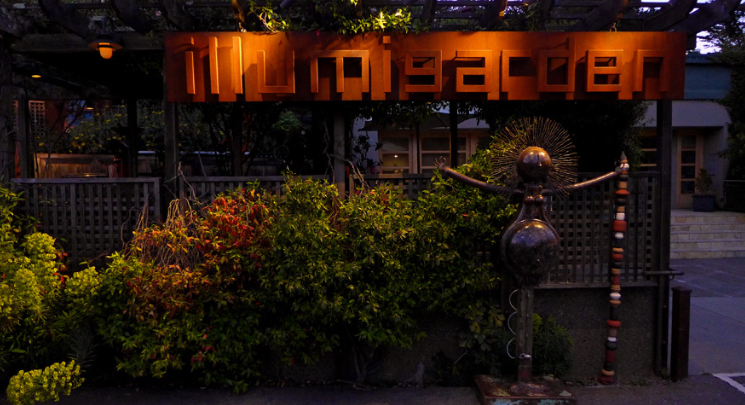On the other side of the Golden Gate Bridge, nestled among the houses of tech giants and endless yoga studios, lies the myth of old Mill Valley. Originally a town of artists living in the redwoods, most residents had come from all over the nation to celebrate the “Summer of Love” and remained long after, designing and preserving a town awash with generational art, performance, and protest.
But as time passed, the rest of the world moved on. The dot-com boom of the early 1990s jump-started San Francisco’s economic re-birth, and the Bay Area was flooded once again in a second mass migration. Now, whimsical artifacts from the Summer of Love juxtapose new-age minimalism, crafting the new, trademark look of what has become one of the wealthiest counties in the United States.
Ultimately, the unintentional question stands. Where have the artists gone?
The History of Mill Valley
During the summer of 1967, San Francisco’s Haight-Ashbury district was flooded with a multitude of youthful individuals, numbering around 100,000. These adventurers, including artists, musicians, vagabonds, and hippies were drawn to the area to experience the cultural phenomenon commonly known as the “Summer of Love.” The airwaves were awash with revolutionary types of rock ‘n’ roll, psychedelic drugs were abundant, and the concept of free love was readily embraced. These idealistic, countercultural thinkers were rebelling against societal expectations.
This hippie counterculture was widely present in Marin County, but specifically in the town of Mill Valley. According to the Mill Valley Chamber of Commerce, at least 36,000 people attended the two-day “Fantasy Fair” in Mill Valley, one of the first in a series of music events during the Summer of Love.
“I was growing up in Mill Valley in the ‘70s, and it was a different culture. It always had money, however, it had so much more of a chill, art, music vibe to it,” multi-generation Mill Valley resident Kerry Rose said.
As the 2000s emerged, so did a new world of tech and corporations in San Francisco. The suburbs began witnessing an influx of young tech executives and corporate America successes, attracted to a more nurturing environment, a place where they want to raise their children. This trend is particularly evident in Mill Valley, which is renowned for embodying the epitome of liberal, nature-loving, and laid-back Marin County culture.
“I moved from San Francisco, even though my parents’ jobs were there. It is a much more laid-back area for raising kids,” senior Allison Lee at Redwood High School said. “I would say it’s most common for parents here to commute to the city for work.”
Before the technology boom, there was a high concentration of families living in San Francisco. According to an article by the New York Times, today it has the lowest percentage of children of any of the largest 100 cities in America.
Theo Emison, a lawyer who gained success working in San Francisco, moved to Mill Valley when his daughters were toddlers. “Mill Valley felt like a Swiss village to us at that time in life, in some senses a surreal little town just across the Golden Gate Bridge,” Emison said. Nature is a large pull factor for Marin County.
In addition to the environment, the safety of San Francisco was a concern to many when thinking about raising kids. “In 2007, we had eight shootings within a 3-block radius of our home in San Francisco and decided it was time to move,” Emison said.
When new people and new money arrived in Mill Valley, the culture shifted. “The difference between the town I grew up in and the town my children are growing up in is money,” Barbara Yamanaka, second-generation Mill Valley resident said.
In addition to a more affluent community, other aspects have majorly changed as well. “I notice that Mill Valley has gotten way less diverse,” Yamanaka said.
In a historically very white town, Mill Valley presents itself as a town actively against racial prejudice. According to the United States Census Bureau, Mill Valley’s population is 84.6% white. Emison grew up in Alamo, a small town in the South, and compares racism in Mill Valley to his hometown.
Emison notices that a paradigm exists between the two towns. Systemic poverty and racism are pervasive in Alamo.
“It’s not uncommon to see a Confederate flag in the back window of a pickup truck. Despite the high degree of poverty and racism, all people tend to use the same facilities. There’s one grocery store and that’s where everyone goes. There’s one school and that’s where everyone goes,” Emison said. Unlike Alamo, Mill Valley is highly educated and affluent. Mill Valley residents tend to be socially progressive and profess to be politically correct and non-racist. “Flying a Confederate flag in a pick-up truck would be scorned in Mill Valley. Yet Mill Valley is almost completely segregated. White residents of Mill Valley are benefactors of white privilege and in a large way complicit in systemic racism that locks Black persons out of education, home ownership, opportunity, and social mobility.”
Sophie Safrit, a student at Tam, moved from South Carolina to Mill Valley in elementary school. She believes that the public school system is a defining aspect of Mill Valleys affluence.
“In the South, if you wanted a good education, you needed to pay for private tuition. It’s unfortunate that wealth is what determines how good a state-run school is,” Safrit said.
What Remains Today
Among this new wave of Mill Valley folks remains a smaller, yet ever-influential community of artists. However, with living expenses being exponentially higher than those of the national average — a staggering 270 percent higher in housing expenses, according to software company PayScale — most artists living in Mill Valley can’t make their living off of purely art-related endeavors. Paired with the town’s deeply-rooted appreciation for the arts, this reality has led to numerous local businesses revolving around unique combinations of industry and artistry.
Around the corner from downtown Mill Valley, landscape lighting company Illumigarden is one of these most notable businesses. The store opened in 2007, replacing the former garden store Smith & Hawken that had occupied the space since the ‘80s.
Illumigarden owner and landscape designer Michael Pringle explained that amidst the 2007-2008 financial crisis, he had to come to terms with people no longer retail shopping like they had a decade prior.
“I knew that [times had changed]. And so it didn’t matter to me, it was more about ‘I’m going to give this as a gift to the community. I’m going to do my lighting, consult design, and do what I love and let the artists express themselves in our space and let things unfold,’” Pringle said.
This attitude guided Pringle in his decision to create the all-hours, open-to-the-public outdoor showroom or garden space that Illumigarden is known for.
“I was always open-minded to the fact that Illumigarden isn’t something where somebody has to be there all the time trying to sell you something. So I just let it evolve,” Pringle said. “The space is less driven by retail than Smith & Hawken was and more driven by exploration and community space.”
These aspirations for the garden and store as a whole have been most remarkably achieved through Illumigarden’s collaboration with local artists. Representing over 40 artists with a piece of artwork or two from each, the store has become a unique art outlet like no other in Mill Valley. The art serves as decoration enjoyed by all customers who stop by, but most are also for sale. Pringle curates this collection primarily through word-of-mouth; community members bring in their own work or suggest Pringle get in contact with artists they know and could see in the space.
“Every artwork that I either buy or curate has to have that certain feeling, it’s a hard to explain beauty. Something aesthetic that reveals an appreciation of art. Those things,” Pringle said.
In years past, artwork submitted to Illumigarden was a part of Mill Valley’s monthly Tuesday Art Walk display. The Tuesday Art Walk takes place on the first Tuesday of every month, inviting the community to stroll through downtown from 5:30-7:30 p.m. to “view exciting exhibits featuring a wide range of art by local artists,” the hosting Mill Valley Arts Commission states. After the COVID-19 pandemic, Pringle decided to settle down in terms of art shows and focus primarily on letting Illumigarden unfold as a community space.
“Mill Valley does a good job at the city level with the arts … like with the art commission and making sure that art stays alive,” Pringle said, further commenting on his experience with the Tuesday Art Walk. “We also have the O’Hanlon center, which comes from people who have been part of Mill Valley in the past who have gifted their land for the appreciation of art.”
He added that in some ways, there is a “greater appreciation” for art in Mill Valley. “Our community appreciates the space and sees it as a gift … But I think it’s only because of where it is and because people want to support local businesses in Mill Valley,” Pringle said. “But I think appreciation of art is everywhere, in every community, and it’s just sometimes on a different level.”
Pringle also addressed Mill Valley’s shift away from the 1960s counterculture movement. “Having been in Mill Valley for a long time and talking to people who have been here since the ‘60s, I think that it has shifted [away from the counterculture movement]. But I think that the sort of families and people who come here still gravitate to a bohemian community,” Pringle said. “I think there are a lot of people who have worked hard to keep that sort of spirit alive.”
He attributes this — albeit decreased — prevalence of the Summer of Love energy and related appreciation of the arts to Mill Valley’s “proximity to nature and the mountain,” as well as neighboring San Francisco. Other local artists have also ascribed their creativity to the surrounding natural world. Tom Killion, a household name to many Mill Valley residents, is one such individual who creates intricate woodcut prints of the California landscape.
This born-and-raised Mill Valley resident was interviewed by the Mill Valley Oral History Program in 2016 and explained that the natural environment that his childhood was set in greatly influenced him as a young artist. “I fell in love with this place, and not just the natural beauty of Mount Tam and the trees, but how the houses and everything fitted in. Something really got me about that as a child,” Killion said in the interview. “I went all over Mill Valley and Marin County drawing pictures of Mount Tamalpais, collecting these pictures while I was in high school and selling some at the art fair.”
Steve Scholl, another long-time Mill Valley resident and Bay Area local, also highlighted the influence of Mill Valley’s nature. “Nature is a big inspiration for people and it definitely allows you to express yourself. I think it lends itself to more positive art whereas when you’re stuck in an urban environment, your creativity might lean towards rebelling against your surroundings, trying to bring humanity into a sterile environment,” Scholl said.
For the past ten years, Scholl has created sculptural art pieces out of copper. He started the practice by hammering letters into small amounts of copper, inscribing “thank you” for his kids’ teachers at the end of the school year. The pieces have grown in size and complexity since, with several on display in Illumigarden. “I think art is personal for people, what it means to them in their lives. For me, I look at it as sort of a meditation. It’s a practice for me to work on focusing and letting the unconscious come out,” Scholl said.
However, the presence of art in the Mill Valley community is not only the product of preexisting beauty but the source of it as well. “Art makes communities more livable. Having that creative, interesting side, you can express the community’s interests through art whether it’s murals, sculptures, or interesting architecture,” Scholl said.
“Art definitely builds community by conversation, by evoking thought, by feeling a sense of purpose,” Pringle said. “I think we as humans sort of need that structure and sort of spiritual connection to something that’s beautiful. And we even need those conversations that surround whether something is beautiful or not … It’s incredible what art can do for people.”
“I think art is there to open minds. And I think that one of the biggest things that we need to have in society is being open-minded,” owner of “The Tree and Shovel” Shane Kennedy said. Similar to Illumigarden, The Tree and Shovel is a Mill Valley-based landscape business that takes care to intertwine art throughout each project via unique sculptures. “You don’t have to even like it. But you have to look at it and art provides that … So I think that’s one thing that art does for a community.”
Although these values have remained at the core of Mill Valley since the Summer of Love, the number of artists able to make ends meet here has indefinitely gone down over the past 60 years. “Mill Valley is more exclusive than it was when I first got here [in 1988]. As many parts of the country have, these towns and special places become very exclusive … you don’t really get that cross-section of the population at all really,” Kennedy said.
Scholl also mentioned the impact of the increased cost of living. “It was easier to get by financially [in the 1960s], so there were a lot of hippies. San Francisco was kind of hardcore. After a couple of years of the whole movement, people wanted to get out of the urban craziness and came north. Mill Valley was one of the epicenters … so there were a lot of creative people and it was easier to find a niche and be creative in different ways,” Scholl said. “But now, middle class isn’t really a word thrown around in these parts. People move further north.”
In spite of these cultural shifts over the past few decades, both Kennedy and Scholl believe that the current generation of Mill Valley artists interact with artwork similar to how they did growing up. Kennedy highlighted how the progress has remained the same, particularly in the timeless element of needing to “say yes enough and not saying no,” allowing yourself to be open to the work you produce. “You may look at your art in 10 years and go, ‘gee what was I thinking?’ But at the same time, it’s part of your evolution as a human being and as an artist. So you just have to do it,” Kennedy said.
“I think the kids who are tuned in to art at any level, at any time period, will find art and the art can change,” Scholl said, agreeing with the notion of an ageless approach to artistry.
He did, however, contrast one facet of his experience to that of teenagers today. “When I was at college, I got involved with some friends and we put on music. And so we put posters together and you would go to the art store and get these sheets of letters … now it’s just your computer and what font, what size, and what color. So [technology] has made it easier in a lot of ways,” Scholl said.
Tamalpais High School senior Grace Young agreed that many core values of art have remained before expanding upon the differences between artists today and in the 1960s. “With the rise of technology and social media, art has become more accessible and available to a wider audience. People are no longer limited to physically visiting galleries or museums to experience art, they can now view and appreciate it from the comfort of their own homes through online platforms. It’s fascinating to see how social media has changed the way we consume, create, and appreciate art,” Young said.
She further underscored the apparent gravitation towards creating art that isn’t just beautiful, but meaningful for the creator and audience as well. “Many artists today are using their platforms to raise awareness of important issues and to inspire positive change … Art has the power to inspire, challenge, and provoke thought, and I believe that’s something we can all agree on, regardless of our personal beliefs or perspectives,” Young said. “It’s an exciting time to be an artist, and I can’t wait to see where this shift takes us in the future.”
It’s safe to say, the artists have not left. The effervescence of their impact on the Mill Valley has evolved with the changes of time, but never fully diminished.
“Mill Valley will always be special in that it is surrounded by San Francisco, Stinson Beach, and Redwoods.” Rose said. “It has changed and become more aggressive, more fast-paced with its newfound affluence, however, regardless of that, Mill Valley is a magical place, and I don’t think that will change.”






